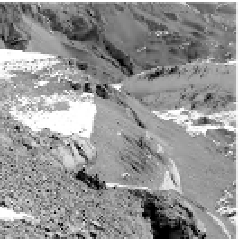Geology Reference
In-Depth Information
Tectonic
geomorphology
at late Cenozoic
time scales
10
Actively deforming ranges and orogens that
evolve over hundreds of thousands to millions
of years result from a long-term interplay
between constructional and erosional processes.
Mean rates of fault slip and folding create spatial
patterns of bedrock uplift or subsidence that
drive the evolving shape of unmodified tectonic
landforms, whereas the summation of all active
erosional and depositional processes determines
how those pristine geometric forms are modified
over time. Currently observable deformation
patterns, climate, and erosion rates may have
only tangential relevance to a range's overall
evolution. At such long time scales, climate will
have varied between glacial and interglacial
conditions dozens of times, and nearly all
geomorphic thresholds will potentially have
been crossed, perhaps numerous times. Faults
that are currently active are unlikely to be the
faults that were predominantly responsible for
the building of the mountain range, especially in
contractional mountain belts. Consequently,
the rates of active tectonic and geomorphic
processes that we can examine during our
present interglacial conditions are unlikely to
be representative of average rates over millions
of years. Whereas we can use our knowledge
of tectonic and erosional processes at short and
intermediate time scales to understand the
phenomena that build and tear down mountains,
a more integrative perspective is commonly
needed to synthesize the growth and decay of
orogens at long time scales.
Some landscape responses are best viewed at
long time scales. For example, dynamic topogra-
phy can be represented by long-wavelength
crustal tilting that is driven by mantle or deep
crustal processes. Such subtle tilting only
expresses itself geomorphically at long time
scales. Migration of drainage divides at long
time scales may result from sustained gradients
in shortening across a landscape, asymmetric
rock uplift, different base levels on opposite
sides of a range, or storm tracks that are persis-
tently followed. Such divide migration in bed-
rock massifs is commonly difficult to discern at
intermediate or shorter time scales, but it may
be inferred at long time scales either where
a pristine landform shape that is attributable
solely to deformation can be reconstructed,
where along-strike ergodic substitutions can be
made in laterally propagating ranges, or where
comparisons can be made among analogous
ranges that differ in only a few major variables.
Over these prolonged intervals of tectonic
activity, the record of detailed interactions of short-
term deformation and surface processes is often
obscured owing to their incremental impact on
the present-day landscape. In the analysis of
long-term deformation, the appropriate suite of
questions to pose and the approaches to solve
them differ from those applied to processes and
landforms at shorter time scales. In general, a
larger spatial framework (hundreds to thousands
of square kilometers) is appropriate for addressing
the products of long-term deformation. Bedrock































